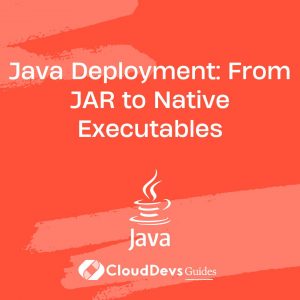Java Deployment: From JAR to Native Executables
In the ever-evolving landscape of software development, the process of deploying Java applications has seen significant advancements. From the traditional approach of packaging applications into JAR (Java ARchive) files to the modern method of creating native executables, developers now have a range of options to choose from based on their specific requirements. In this post, we’ll explore the journey of Java deployment, highlighting the advantages and considerations of each approach.
Evolution of Java Deployment
JAR Files
JAR files have long been the standard for packaging Java applications. They contain compiled Java classes, resources, and metadata, making it easy to distribute and execute Java programs across different platforms. With tools like Apache Maven and Gradle, developers can efficiently manage dependencies and build JAR files for their projects.
However, while JAR files offer portability and ease of distribution, they require the Java Runtime Environment (JRE) to be installed on the target system. This dependency can sometimes lead to compatibility issues and version conflicts, especially in environments where managing Java installations is challenging.
Java Web Start (Deprecated)
Java Web Start was introduced as a mechanism for deploying Java applications via the web. It allowed users to launch applications directly from a web browser without the need for manual installation. However, due to security concerns and the shift towards modern web technologies, Java Web Start has been deprecated in recent Java releases.
Native Executables
To address the limitations of JAR files and enhance the user experience, developers have turned to native executable generation. Tools like GraalVM and Excelsior JET enable the compilation of Java applications into standalone native executables, eliminating the need for a separate JRE installation.
Advantages of Native Executables
Improved Performance
Native executables are optimized for the target platform, resulting in faster startup times and reduced memory overhead compared to running Java applications in a virtual machine. This improved performance is particularly beneficial for latency-sensitive or resource-intensive applications.
Simplified Distribution
With native executables, deploying Java applications becomes more straightforward as there is no dependency on the JRE. Users can run the application directly without worrying about Java compatibility or installation issues, streamlining the deployment process for both developers and end-users.
Enhanced Security
By removing the need for a separate JRE, native executables can mitigate certain security risks associated with outdated or vulnerable Java installations. Additionally, developers have more control over the runtime environment, allowing them to implement custom security measures tailored to their application’s requirements.
Considerations for Native Executables
Compatibility
While native executables offer improved performance and distribution benefits, developers must ensure compatibility with different operating systems and architectures. Cross-compilation tools and platform-specific optimizations may be required to generate binaries for multiple targets.
Resource Consumption
Although native executables can optimize resource utilization compared to traditional Java deployments, developers should still monitor and optimize memory usage, especially in resource-constrained environments such as embedded systems or mobile devices.
Development Workflow
Integrating native executable generation into the development workflow may require adjustments to build scripts and toolchains. Developers should familiarize themselves with the specific requirements and limitations of the chosen compilation tool to maximize efficiency and productivity.
Conclusion
From JAR files to native executables, the landscape of Java deployment has evolved to meet the evolving needs of developers and end-users. While traditional approaches offer portability and flexibility, native executables provide enhanced performance, security, and distribution capabilities. By understanding the advantages and considerations of each approach, developers can choose the most suitable deployment method for their Java applications, ensuring optimal performance and user experience.
External Links for Further Reading
Table of Contents









